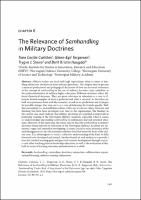Chapter 8 The Relevance of Samhandling in Military Doctrines
| dc.contributor.author | Carlsten, Tone Cecilie | |
| dc.contributor.author | Torgersen, Glenn-Egil | |
| dc.contributor.author | Steiro, Trygve J. | |
| dc.contributor.author | Haugdal, Berit Kristin | |
| dc.date.accessioned | 2018-10-08 11:50:57 | |
| dc.date.accessioned | 2020-04-01T12:20:27Z | |
| dc.date.available | 2020-04-01T12:20:27Z | |
| dc.date.issued | 2018 | |
| dc.identifier | 1001649 | |
| dc.identifier | OCN: 1076747135 | en_US |
| dc.identifier.uri | http://library.oapen.org/handle/20.500.12657/28313 | |
| dc.description.abstract | "Military leaders are faced with high expectations when it comes to handling unforeseen situations in joint military operations. This chapter aims to present a nuanced professional and pedagogical discussion of how an increased awareness of the concept of samhandling in the use of military doctrines may contribute to the professionalization of military higher education. Different doctrines reflect different theoretical decisions. They are given relevance in education as a way to illustrate formal examples of what is preferred and what is rejected. As doctrines are built on experiences from real-life scenarios, as well as on predictions and strategies for possible change, they may serve as a way of balancing the branch-specific “hidden curriculum”, i.e. an established culture with a set of current values, behavior and thinking that have been developed over time in the organization. The findings in the current case study indicate that military doctrines are regarded as important in leadership training at the Norwegian Military Academy, especially when it comes to understanding and guiding samhandling in unforeseen and risk-oriented situations. However, at the same time, the terms used to describe samhandling in military doctrines found relevant in education at the Norwegian Military Academy are numerous, vague and somewhat overlapping. It seems crucial to raise awareness of the underlying processes and the relational ambition level that forms the basis of the chosen term. It is advantageous to reach a collective understanding of the kind of skills that need to be developed and trained. Another benefit of such analysis is to provide a basis for clarified learning goals and practical scenario development through exercises and other teaching plans in leadership education, as well as the evaluation of this, both in terms of learning outcomes and education as a whole." | |
| dc.language | English | |
| dc.subject.classification | thema EDItEUR::J Society and Social Sciences | en_US |
| dc.subject.classification | thema EDItEUR::J Society and Social Sciences::JW Warfare and defence | en_US |
| dc.subject.classification | thema EDItEUR::J Society and Social Sciences::JW Warfare and defence::JWK Military and defence strategy | en_US |
| dc.subject.other | Samhandling | |
| dc.subject.other | curriculum | |
| dc.subject.other | doctrines | |
| dc.subject.other | interaction | |
| dc.subject.other | collaboration | |
| dc.subject.other | organizational | |
| dc.subject.other | learning | |
| dc.subject.other | military training | |
| dc.subject.other | unforeseen | |
| dc.title | Chapter 8 The Relevance of Samhandling in Military Doctrines | |
| dc.type | chapter | |
| oapen.identifier.doi | 10.23865/noasp.36.ch8 | |
| oapen.relation.isPublishedBy | bf7b42a4-6892-42e3-aaf8-8f32c8470a8b | |
| oapen.relation.isPartOfBook | 2724fb8b-60f0-4a89-9f93-98ba00ad6223 | |
| oapen.pages | 26 | |
| oapen.place.publication | Oslo | |
| oapen.identifier.ocn | 1076747135 |

